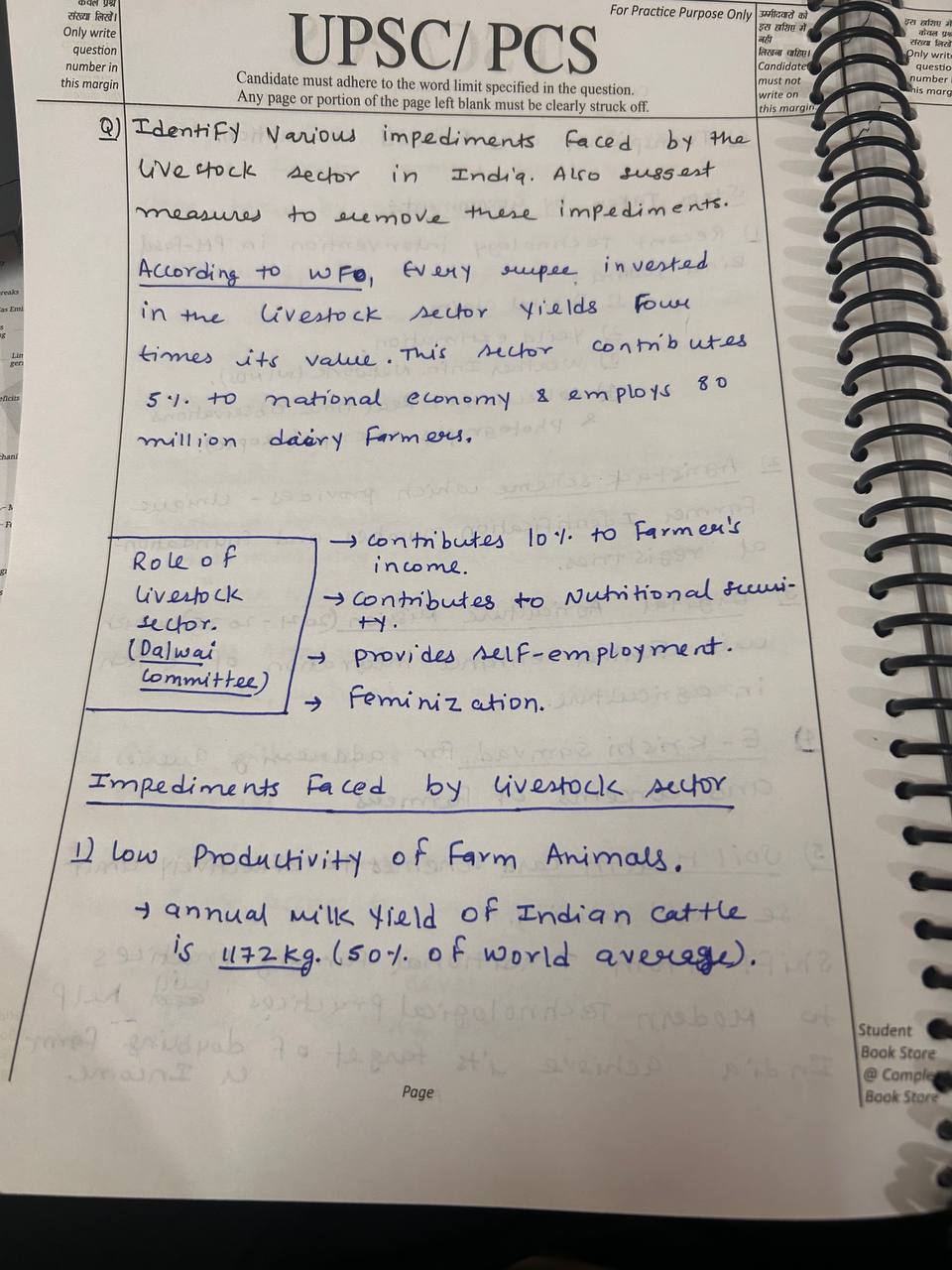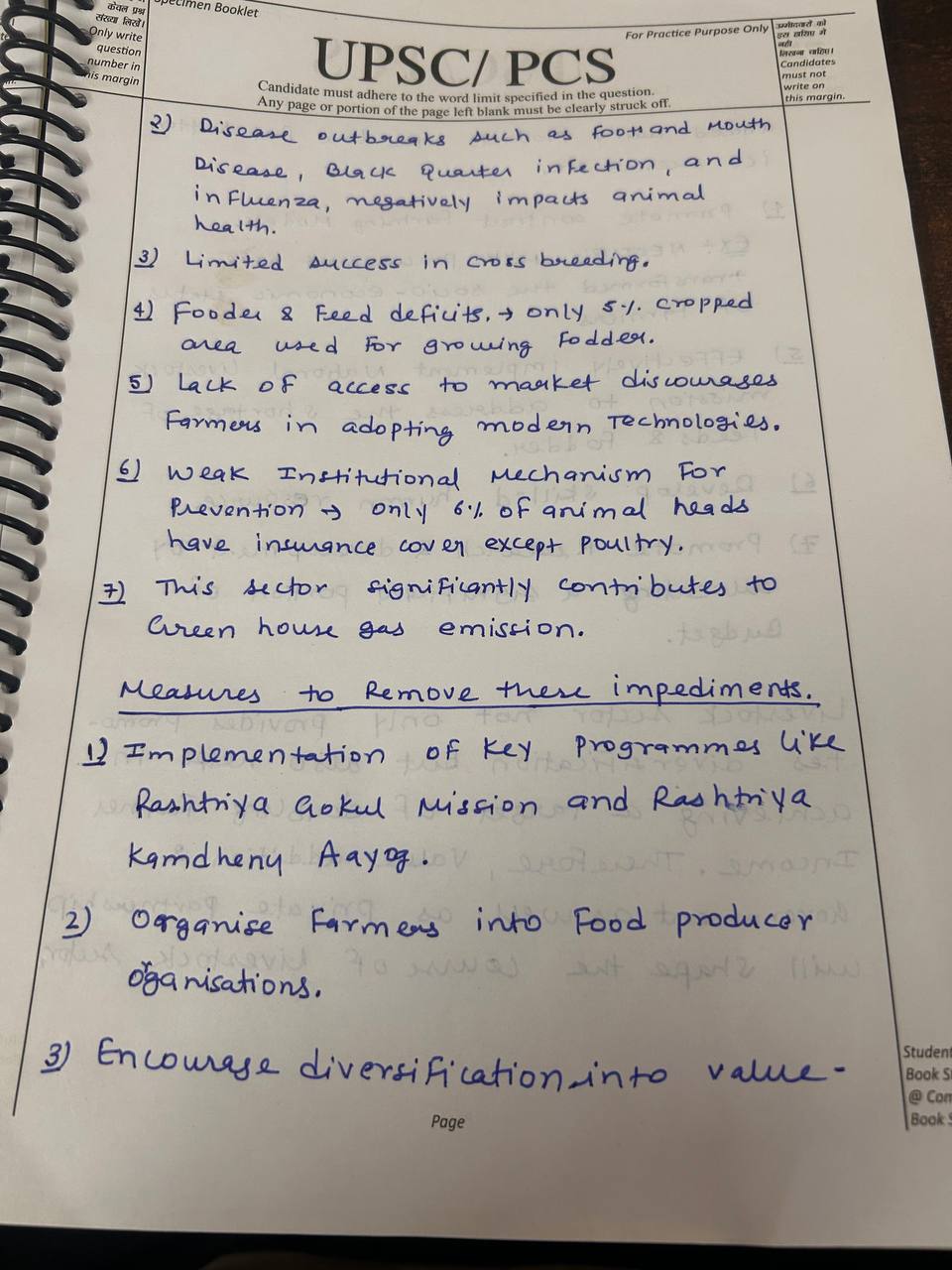Roadmap for Answer Writing 1. Introduction Context: Briefly introduce the NHM, established in 2005 by the Ministry of Agriculture and Farmers’ Welfare, aimed at developing horticulture. Significance: Highlight the importance of NHM in enhancing agricultural productivity and farmer livelihood. 2. Role of NHM in ...
- Recent Questions
- Most Answered
- Answers
- No Answers
- Most Visited
- Most Voted
- Random
- Bump Question
- New Questions
- Sticky Questions
- Polls
- Followed Questions
- Favorite Questions
- Recent Questions With Time
- Most Answered With Time
- Answers With Time
- No Answers With Time
- Most Visited With Time
- Most Voted With Time
- Random With Time
- Bump Question With Time
- New Questions With Time
- Sticky Questions With Time
- Polls With Time
- Followed Questions With Time
- Favorite Questions With Time
Mains Answer Writing Latest Questions
List the several obstacles that India’s cattle industry faces. Additionally, recommend actions to get rid of these obstacles.(Answer in 200 words)
Roadmap for Answer Writing 1. Introduction Define organic and natural farming. Organic farming involves using natural inputs and processes to enhance soil health, biodiversity, and overall environmental sustainability. Natural farming, a more traditional practice, relies heavily on mimicking natural ecosystems with minimal human intervention. Key ...
-
Best Answer
Model Answer Introduction Organic and natural farming are sustainable agricultural systems that prioritize ecological balance, biodiversity, and minimal use of synthetic inputs. These farming methods focus on nurturing soil health, promoting natural processes, and creating a balance between agricultRead more
Model Answer
Introduction
Organic and natural farming are sustainable agricultural systems that prioritize ecological balance, biodiversity, and minimal use of synthetic inputs. These farming methods focus on nurturing soil health, promoting natural processes, and creating a balance between agriculture and the environment. Both approaches are gaining recognition for their contribution to sustainable agricultural production.
Principles of Organic and Natural Farming:
1. Principles of Organic Farming:
- Principle of Health: Organic farming aims to enhance the health of soil, plants, animals, humans, and the planet, all of which are interconnected.
- Principle of Ecology: Organic farming works with natural ecological systems and cycles, maintaining and promoting them for sustainability.
- Principle of Fairness: Organic farming supports systems of production, trade, and distribution that are open, equitable, and accountable for environmental and social costs.
- Principle of Care: Organic farming is managed responsibly to protect the health and well-being of future generations and the environment.
2. Principles of Natural Farming
- No-Till Farming: In natural farming, the earth naturally cultivates itself through the action of plant roots, microorganisms, and earthworms, avoiding the need for tilling.
- No Weeding: Weeds are not eliminated but suppressed by covering the land with straw and promoting ground cover.
- No Chemical Fertilizers: The soil naturally maintains its fertility through the orderly cycle of plant and animal life, without relying on chemical fertilizers.
- No Chemical Pesticides: The natural balance in ecosystems prevents the dominance of any one species, and chemical pesticides are avoided.
Contribution to Sustaining Agricultural Production
1. Preservation of Soil Health:
- Both organic and natural farming practices focus on maintaining soil fertility and structure, preventing soil degradation, and ensuring long-term productivity.
- By avoiding synthetic fertilizers and chemicals, these practices promote the development of healthy soil ecosystems that enhance the soil’s ability to retain moisture and nutrients.
2. Reduced Environmental Impact:
- The minimal use of synthetic chemicals in both farming methods helps prevent pollution of soil and water bodies, safeguarding biodiversity.
- Natural and organic farming methods reduce the overall environmental footprint of agriculture, promoting sustainability in the long run.
3. Healthier Food:
- Produce from organic and natural farming is often seen as healthier since it contains fewer chemical residues, which is beneficial to both consumers and the environment.
- As a result, these farming practices contribute to better food quality and public health.
4. Cost-Effectiveness:
- These practices can lower the costs of farming inputs, as farmers reduce or eliminate their reliance on expensive chemical fertilizers and pesticides.
- This cost reduction improves farmers’ income and promotes financial sustainability.
5. Enhanced Resilience:
- Organic and natural farming encourage biodiversity through crop rotation and integrated pest management, which help crops resist pests, diseases, and extreme weather events.
- These systems also improve soil structure, allowing crops to better withstand droughts and floods.
Limitations
- Transition Period: Shifting from conventional farming methods to organic or natural farming can be time-consuming and challenging. In some cases, such as Sri Lanka’s recent agricultural crisis, the transition can be risky if not carefully managed.
- Yield Variability: Natural farming methods may initially result in lower yields, especially during the transition period, before the soil and ecosystem stabilize.
- Labor-Intensive: Natural farming often requires more manual labor for tasks like mulching, composting, and pest management, which can increase the workload for farmers.
Roadmap for Answer Writing Introduction Contextualize the importance of millets: Mention the benefits of millets, including their nutritional value (high in fiber, minerals, and beneficial for managing diabetes and obesity), climate resilience, and ability to grow in water-scarce conditions. Link to the problem: ...
-
Best Answer
Model Answer Despite their numerous benefits, such as being nutritionally rich and climate-resilient, millets have seen a decline in adoption by Indian farmers. Several factors contribute to this low uptake: 1. Low Demand and Consumption Millets were once a staple in Indian diets but their consumptiRead more
Model Answer
Despite their numerous benefits, such as being nutritionally rich and climate-resilient, millets have seen a decline in adoption by Indian farmers. Several factors contribute to this low uptake:
1. Low Demand and Consumption
Millets were once a staple in Indian diets but their consumption has sharply declined. The per capita consumption fell from 32.9 kg in 1962 to just 3.87 kg in 2022. Factors contributing to this include the longer cooking time required for millets compared to rice and wheat, a lack of value-added millet-based products, and diminishing traditional knowledge of millet-based recipes.
These factors have led to reduced consumer interest and demand for millet Productivity and Marginal Land Cultivation Millet productivity averages only 1 to 1.5 tonnes per hectare, which is significantly lower than that of rice and wheat. This low yield results in reduced profitability for farmers, forcing them to grow millets on marginal lands with even lower productivity potential. Consequently, farmers are often discouraged from choosing millets over more profitable crops .
2. Government Procurement
The government’s procurement of millets remains insufficient, which further exacerbates the issue. For example, the procurement rates for pearl millet, sorghum, and finger millet are extremely low, ranging from 1% to 15% of their total production. In contrast, procurement for staple crops like rice and wheat is much higher, ensuring better prices and stability for these crops .
3. Poor Seed Storage Issues
Farmers often face challenges with low-quality seeds, which are either contaminated with weeds or diseases, reducing the chances of a good yield. Additionally, millets have a shorter shelf life and are prone to pest infestation during storage, leading to higher wastage and decreased profitability .
Conclusion
To boost millet cultivation, India needs to focus on improving seed quality, enhancing government procurement, providing better storage solutions, and developing modern processing technologies. These efforts can drive both production and consumption, enabling millets to regain their role in India’s agricultural landscape.
See less
Roadmap for Answer Writing Introduction Brief Overview of the Yellow Revolution: Begin by introducing the Yellow Revolution, also known as the Oilseed Revolution, which started in 1986. Aim: To increase domestic production of oilseeds, including mustard, sunflower, and soybean, to reduce dependency on ...
-
Best Answer
Model Answer Introduction The Yellow Revolution, also known as the Oilseed Revolution, was a significant transformation in India's agricultural sector. Launched in 1986, this movement aimed to boost the production of oilseeds, improving the nation's self-sufficiency in edible oils. It played a vitalRead more
Model Answer
Introduction
The Yellow Revolution, also known as the Oilseed Revolution, was a significant transformation in India’s agricultural sector. Launched in 1986, this movement aimed to boost the production of oilseeds, improving the nation’s self-sufficiency in edible oils. It played a vital role in reducing India’s dependence on oilseed imports and enhancing food security.
About the Yellow Revolution
- Origin:
- The Yellow Revolution began in 1986 under the Oil Technological Mission, continuing until 1987, with a focus on increasing the production of oilseeds.
- Coverage:
- It focused on major oilseeds such as mustard, soybean, and sunflower.
- Yield Improvement:
- The revolution introduced high-yielding hybrid varieties of oilseeds, leading to a significant increase in yields. For example, mustard yields increased from around 675 kg per hectare in 1960-61 to over 1,500 kg per hectare in recent years.
- Global Impact:
- Today, India is the fourth-largest producer of oilseeds globally, accounting for about 20% of the global area and 10% of the total production.
Significance of the Yellow Revolution for India’s Economy:
- Reduced Import Dependence:
- The increase in domestic production helped reduce India’s reliance on oilseed imports, improving the trade balance and ensuring greater economic stability.
- Rural Employment and Livelihoods:
- Oilseed cultivation created new job opportunities in rural areas, contributing to livelihood enhancement. Farmers benefitted from increased income through oilseed farming, processing, and marketing.
- Value Addition and Agro-processing:
- The rise in oilseed production also led to the growth of agro-processing industries, including oil extraction and refining units. This added value to raw oilseeds and generated additional economic returns.
- Boost to Agricultural Productivity:
- The Yellow Revolution encouraged the adoption of modern farming practices, improved seed varieties, and advanced technology, all of which boosted agricultural productivity.
- Spillover Effects on Other Industries:
- Oilseeds are not only used in food production but also serve as raw materials for industries like cosmetics, chemicals, soaps, and detergents, contributing to economic growth beyond agriculture.
- Human Capital Development:
- The increased availability of edible oils improved nutrition across the country, leading to better health outcomes and the development of human capital. For example, per capita edible oil consumption rose from 6.4 kg in 1976 to 15.4 kg by 2013.
- Origin:
Roadmap for Answer Writing 1. Introduction Briefly define GM crops and mention their primary objectives, such as increasing yields, enhancing resistance to pests and diseases, and improving tolerance to environmental stresses like drought. Mention the dual nature of the debate: the promise of ...
-
Best Answer
Model Answer Introduction Genetically modified (GM) crops are plants that have been altered through modern biotechnology to include novel combinations of genes. In India, the Genetic Engineering Appraisal Committee (GEAC) is responsible for the approval and commercial release of GM crops. While GM cRead more
Model Answer
Introduction
Genetically modified (GM) crops are plants that have been altered through modern biotechnology to include novel combinations of genes. In India, the Genetic Engineering Appraisal Committee (GEAC) is responsible for the approval and commercial release of GM crops. While GM crops are praised for their potential to enhance yields and resilience, concerns regarding their ecological impact and food safety remain significant.
Role of GM Crops in Enhancing Yields and Resilience
GM crops are designed to tackle several agricultural challenges, contributing to both improved crop productivity and resilience:
- Pest Resistance: GM crops, like Bt cotton, are engineered to be resistant to pests. Bt cotton contains a gene from the bacterium Bacillus thuringiensis, which produces a protein toxic to specific pests, reducing the need for chemical pesticides and ensuring higher yields.
- Drought Tolerance: GM crops can be modified to withstand water stress, which is especially beneficial in areas prone to drought. For example, drought-resistant GM maize can thrive in water-scarce regions, ensuring stable yields even during dry spells.
- Nutritional Enhancement: GM crops like Golden rice have been engineered to combat micronutrient deficiencies. Golden rice, enriched with beta-carotene, helps address vitamin A deficiency, a major health issue in many developing countries.
Ecological and Food Safety Concerns
Despite the potential benefits, GM crops raise several environmental and food safety concerns:
- Biodiversity Loss: The use of herbicide-tolerant GM crops may lead to overuse of specific herbicides, causing the development of herbicide-resistant weeds. This disrupts local ecosystems and reduces plant biodiversity.
- Biosafety Risks: GM crops may unintentionally harm non-target species. For instance, insect-resistant plants could affect beneficial insects, leading to a loss of species diversity.
- Cross-Pollination and Gene Flow: GM crops such as canola can cross-pollinate with wild relatives, potentially spreading modified genes to non-GM populations. This gene flow can affect natural plant varieties and disrupt ecosystems.
- Unintended Ecological Consequences: The introduction of GM crops with resistance to pests may inadvertently harm other organisms, leading to imbalances in the ecosystem. For example, pests may develop resistance to the modified genes, causing a cycle of escalating pesticide use.
Food Safety Concerns
- Allergenicity: There is concern that GM crops could introduce new allergens. The transfer of allergenic genes into GM crops might pose risks to sensitive individuals, raising safety concerns.
- Health Impacts: GM crops often have altered nutritional profiles. While they are engineered for improved traits, the long-term health effects of consuming GM foods remain uncertain, and more studies are needed.
- Resistance Development: Over-reliance on specific GM traits (such as pest resistance) can lead to the evolution of resistant pests or diseases. This would require increased pesticide use, which could harm both the environment and human health.
Way Forward
To address the challenges surrounding GM crops, several measures can be taken:
- Evidence-Based Decisions: Governments should base decisions regarding GM technology on robust scientific research, ensuring that all benefits and risks are carefully evaluated.
- Openness and Transparency: A transparent approach to GM crop regulation can help build public trust. Clear communication about scientific findings and safety protocols is crucial to mitigate concerns.
- Stakeholder Involvement: It is important to involve all relevant parties, including scientists, farmers, consumers, and environmentalists, in decision-making processes. A participatory approach ensures that diverse perspectives are considered.
- Precautionary Principle: Due to the uncertainty surrounding GM technology, adopting a precautionary principle is advisable. This means waiting for broader scientific consensus before rolling out GM crops on a large scale.
- Improved Policy Frameworks: Policymakers should focus on creating frameworks that address pricing, input costs, and equitable benefits for all stakeholders involved in GM cultivation.
- Strong Liability Laws: Enforcing strict liability laws will hold companies accountable for any environmental or unforeseen harm caused by GM technology. This encourages responsible practices and environmental stewardship.




Model Answer Introduction The National Horticulture Mission (NHM) was launched in 2005 by the Ministry of Agriculture and Farmers’ Welfare to enhance the production and productivity of horticultural crops in India. Its primary objective is to develop horticulture to its maximum potential across variRead more
Model Answer
Introduction
The National Horticulture Mission (NHM) was launched in 2005 by the Ministry of Agriculture and Farmers’ Welfare to enhance the production and productivity of horticultural crops in India. Its primary objective is to develop horticulture to its maximum potential across various states.
Role of NHM in Boosting Productivity and Income
Success in Increasing Farmers’ Income
The NHM has significantly impacted farmers’ income through various measures:
Conclusion
The NHM has played a crucial role in transforming horticulture in India, leading to increased production, productivity, and farmer income. However, challenges such as inadequate infrastructure and market access remain, necessitating ongoing efforts to stabilize and enhance farmers’ income.
See less